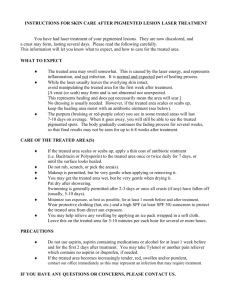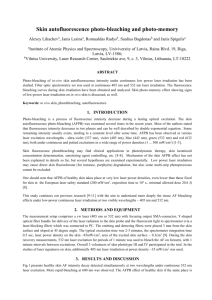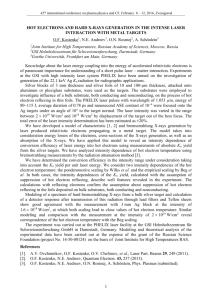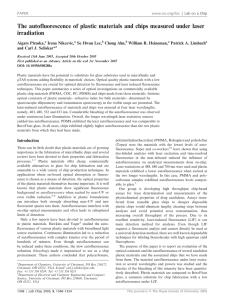Photobleaching measurements of pigmented and vascular skin
advertisement
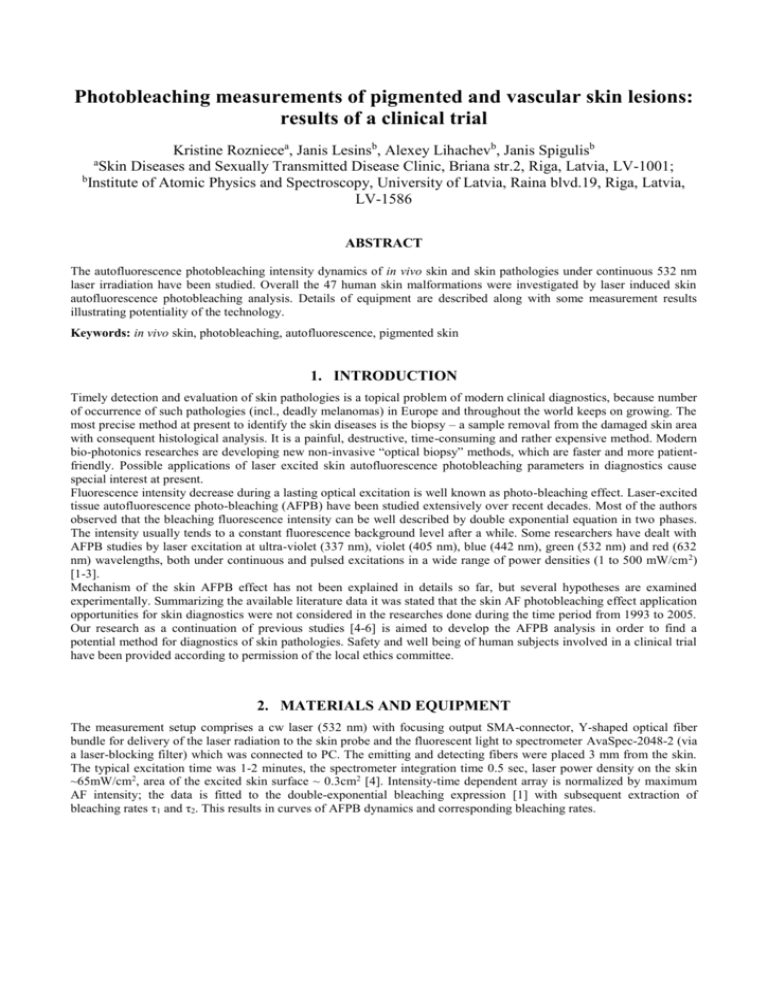
Photobleaching measurements of pigmented and vascular skin lesions: results of a clinical trial Kristine Rozniecea, Janis Lesinsb, Alexey Lihachevb, Janis Spigulisb a Skin Diseases and Sexually Transmitted Disease Clinic, Briana str.2, Riga, Latvia, LV-1001; b Institute of Atomic Physics and Spectroscopy, University of Latvia, Raina blvd.19, Riga, Latvia, LV-1586 ABSTRACT The autofluorescence photobleaching intensity dynamics of in vivo skin and skin pathologies under continuous 532 nm laser irradiation have been studied. Overall the 47 human skin malformations were investigated by laser induced skin autofluorescence photobleaching analysis. Details of equipment are described along with some measurement results illustrating potentiality of the technology. Keywords: in vivo skin, photobleaching, autofluorescence, pigmented skin 1. INTRODUCTION Timely detection and evaluation of skin pathologies is a topical problem of modern clinical diagnostics, because number of occurrence of such pathologies (incl., deadly melanomas) in Europe and throughout the world keeps on growing. The most precise method at present to identify the skin diseases is the biopsy – a sample removal from the damaged skin area with consequent histological analysis. It is a painful, destructive, time-consuming and rather expensive method. Modern bio-photonics researches are developing new non-invasive “optical biopsy” methods, which are faster and more patientfriendly. Possible applications of laser excited skin autofluorescence photobleaching parameters in diagnostics cause special interest at present. Fluorescence intensity decrease during a lasting optical excitation is well known as photo-bleaching effect. Laser-excited tissue autofluorescence photo-bleaching (AFPB) have been studied extensively over recent decades. Most of the authors observed that the bleaching fluorescence intensity can be well described by double exponential equation in two phases. The intensity usually tends to a constant fluorescence background level after a while. Some researchers have dealt with AFPB studies by laser excitation at ultra-violet (337 nm), violet (405 nm), blue (442 nm), green (532 nm) and red (632 nm) wavelengths, both under continuous and pulsed excitations in a wide range of power densities (1 to 500 mW/cm 2) [1-3]. Mechanism of the skin AFPB effect has not been explained in details so far, but several hypotheses are examined experimentally. Summarizing the available literature data it was stated that the skin AF photobleaching effect application opportunities for skin diagnostics were not considered in the researches done during the time period from 1993 to 2005. Our research as a continuation of previous studies [4-6] is aimed to develop the AFPB analysis in order to find a potential method for diagnostics of skin pathologies. Safety and well being of human subjects involved in a clinical trial have been provided according to permission of the local ethics committee. 2. MATERIALS AND EQUIPMENT The measurement setup comprises a cw laser (532 nm) with focusing output SMA-connector, Y-shaped optical fiber bundle for delivery of the laser radiation to the skin probe and the fluorescent light to spectrometer AvaSpec-2048-2 (via a laser-blocking filter) which was connected to PC. The emitting and detecting fibers were placed 3 mm from the skin. The typical excitation time was 1-2 minutes, the spectrometer integration time 0.5 sec, laser power density on the skin ~65mW/cm2, area of the excited skin surface ~ 0.3cm2 [4]. Intensity-time dependent array is normalized by maximum AF intensity; the data is fitted to the double-exponential bleaching expression [1] with subsequent extraction of bleaching rates τ1 and τ2. This results in curves of AFPB dynamics and corresponding bleaching rates. 3. RESULTS AND DISCUSSION Fig.1. presents healthy skin and melanoma autofluorescence intensity dynamics. The figure shows distinguishable differences of photo-bleaching, where AF intensity of healthy skin bleaches exponentially while AF intensity of melanoma varies around the initial value. Fig.2 demonstrates dynamics of AF intensity of healthy skin and pigmented and vascular lesions. Each of skin pathologies has a specific AFPB characteristic, especially differ the dynamic features of pigmented cellular nevus and cherry angioma. In case of pigmented cellular nevus the initial intensity of AF is remarkably low and it tends to hold constant whereas the intensity of cherry angioma (vascular formation) rapidly falls. Results include three skin photo-types of patients (confirmed by dermatologist), i.e., Fig.2 represents cherry angioma of skin phototype II and pigmented cellular nevus of III phototype. 1.05 Pigmented cellular nevus Healthy skin Fluorescence intensity (norm.u.) 1.00 0.95 0.90 0.85 0.80 0.75 0.70 0.65 0.60 0.55 0 10 20 30 40 50 60 Time (sec) Fig.1. Dynamics of the autofluorescence intensity for healthy skin and pigmented cellular nevus, 532 nm laser excitation, registration at 600 nm, power density 65 mW/cm2. Pigmented cellular nevus Cherry angioma Healthy skin 1.05 Fluorescence intetsity (norm.u.) 1.00 0.95 0.90 0.85 0.80 0.75 0.70 0.65 0.60 0.55 0.50 0.45 0.40 0.35 0.30 -10 0 10 20 30 40 50 60 Time (sec) Fig.2. Dynamics of the autofluorescences intensity for some skin pathologies and healthy skin, 532 nm laser excitation, registration at 600 nm, power density 65 mW/cm2. 4. CONCLUSSIONS Results of the present study show considerable sensitivity of skin pathologies of the AF photbleaching analysis method. This methodology has a great potential for fast and patient-friendly diagnostics in dermatology. Dynamics of AFPB intensity are mainly dependent on a variety of skin chromophore distribution of various pathologies. The more homogeneous is a certain pathology structure, the more regular is its bleaching (following the double-exponential model). The smallest intensity bleaching has been observed in cases of highly pigmented cellular nevus, though the most rapid bleaching refers to vascular formations as to cherry angioma and hemangioma. Since the AFPB mechanism is still under discussion, additional studies by use of this methodology would promote a better understanding of the AFPB mechanisms that take place in the human skin. ACKNOWLEDGMENTS The financial support of European Social Fund (grant #2009/0211/1DP/1.1.1.2.0/09/APIA/VIAA/077) is highly appreciated. REFERENCES 1. H. Zeng, C. E. MacAulay, B. Palcic, and D. I. McLean. Laser induced changes in autofluorescence of in-vivo skin, Proc. SPIE, Vol. 1882, 278–290 (1993). 2. A. Stratonnikov, V. S. Polikarpov, and V. B. Loschenov. Photobleaching of endogenous fluorochroms in tissues in vivo during laser irradiation, Proc. SPIE, Vol. 4241, 13–24 (2001). 3. E. V. Salomatina and A.B. Pravdin. Fluorescence dynamics of human epidermis (ex vivo) and skin (in vivo), Proc. SPIE, Vol. 5068, 405–410 (2003). 4. A. Lihachev, J. Spigulis. Skin autofluorescence fading at 405/532 nm laser excitation, IEEE Xplore, 10.1109/NO, 63-65 (2007). 5. A. Lihachev, J. Lesins, D. Jakovels, J. Spigulis. Low power cw-laser signatures on human skin. Quantum Electron, 40 (12), 1077–1080 (2010). 6. J. Spigulis, A. Lihachev, and R. Erts. Imaging of laser-excited tissue autofluorescence bleaching rates, Appl Optics, Vol. 48, Issue 10, D163-D168 (2009).
